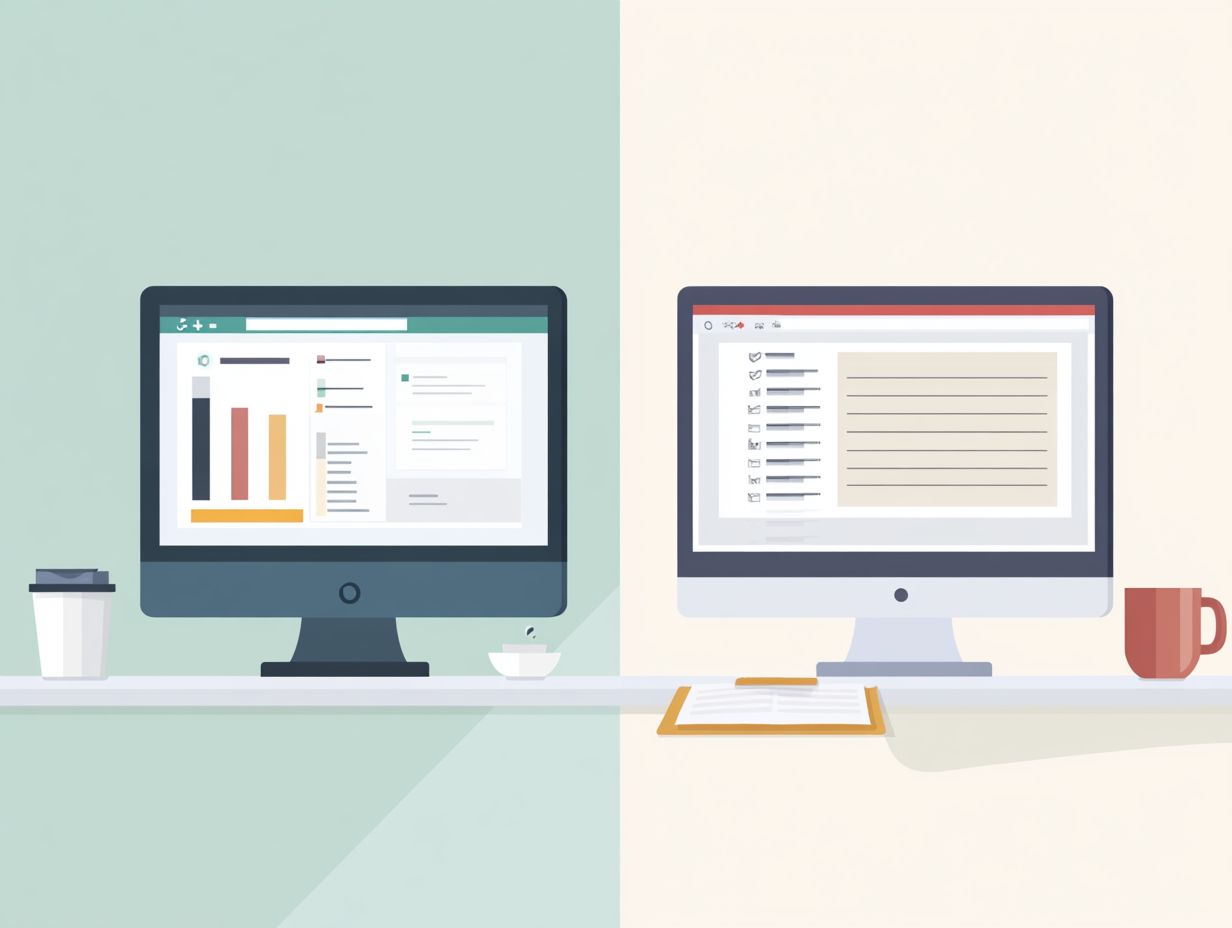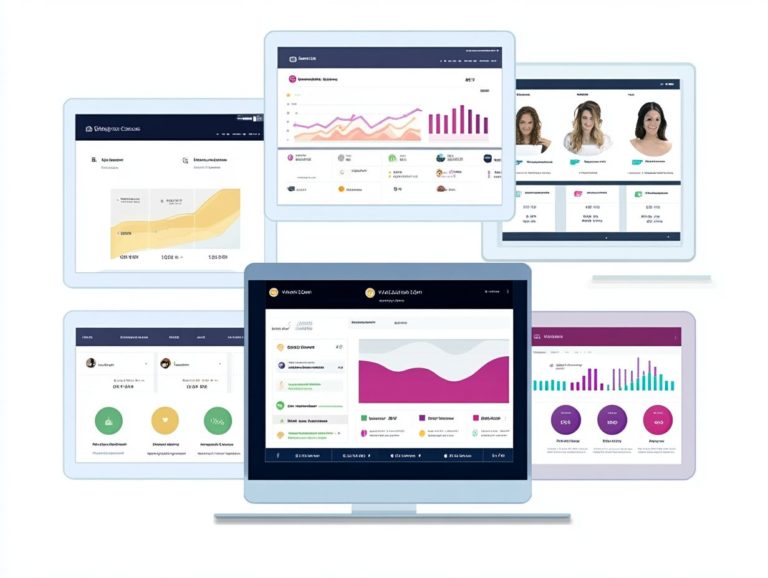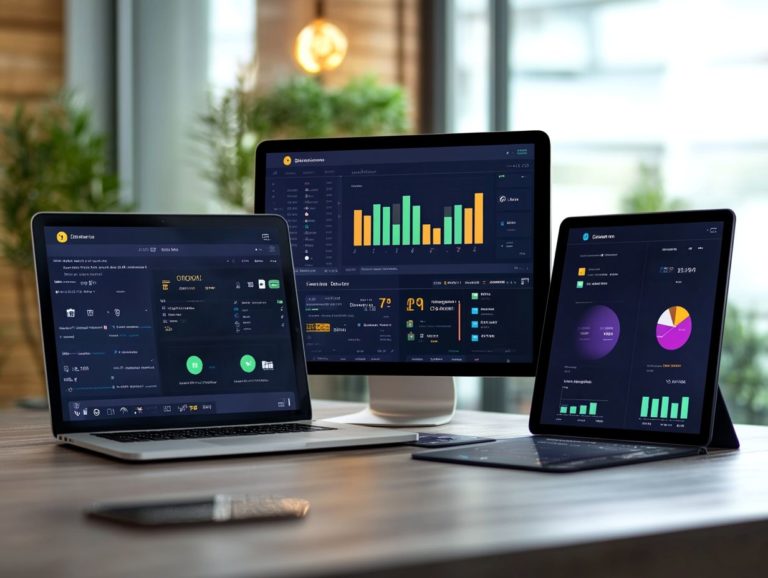Comparative Review: CRM Usability and Interface
In today s competitive business world, choosing the right Customer Relationship Management (CRM) system is crucial for success. With so many options available, understanding how a CRM works can greatly enhance your user experience.
This article explores key factors that shape usability, such as design, navigation, and customization. We will also look at popular CRM systems and their ratings.
You will find user feedback highlighting the pros and cons of each platform. This guidance will help you choose a user-friendly CRM tailored to your needs.
Contents
- Key Takeaways:
- Understanding CRM Usability and Interface
- Factors Affecting CRM Usability
- Popular CRM Systems and their Usability Ratings
- User Reviews and Feedback
- Tips for Choosing a User-Friendly CRM
- Frequently Asked Questions
- What is a Comparative Review for CRM Usability and Interface?
- Why are CRM Usability and Interface important?
- What factors should I consider when comparing CRM Usability and Interface?
- How can I conduct a Comparative Review for CRM Usability and Interface?
- What are some common trends in CRM Usability and Interface?
- Which is more important: Usability or Interface?
Key Takeaways:

A user-friendly CRM should feature a well-designed interface and easy navigation to enhance usability.
Customization and flexibility are important when evaluating a CRM system.
Read user reviews to consider the pros and cons of different options. This will help you find the most suitable CRM for your business needs.
Understanding CRM Usability and Interface
Grasping how CRM usability and interface work is vital for improving customer relationship processes. A smooth user experience can impact how effectively your teams manage sales and track customer insights.
Top companies like Pipeliner CRM, Zoho CRM, and Salesforce focus on user-friendly interfaces for easy access to essential features, boosting sales performance.
As you explore different CRM options and their mobile capabilities, look for one that aligns with your operational needs.
Defining Key Terms
Understanding key terms in CRM software is crucial for using it effectively. Usability refers to how easily you can navigate the system and complete tasks efficiently.
A well-designed interface allows your sales teams to interact smoothly with customer data, improving communication and speeding up decision-making.
For instance, a CRM featuring an intuitive dashboard can reduce training time and increase staff adoption rates.
As you evaluate CRM products, focus on usability and interface, as these factors greatly influence productivity and user satisfaction. Additionally, consider comparing CRM API capabilities for a more comprehensive understanding of each option.
Factors Affecting CRM Usability
Key factors influencing CRM usability include design, navigation, customization, and flexibility. These elements can significantly affect how your organization uses its CRM software.
An attractive user interface improves your overall experience. It makes navigation intuitive, helping your teams manage sales and nurture customer relationships effectively.
Customization options allow you to tailor the CRM to suit your specific needs, ensuring tools like Pipeliner CRM, Zoho CRM, and Salesforce integrate seamlessly with your workflows.

Design and navigation are crucial for CRM software, affecting both user experience and efficiency. An intuitive design should help you quickly find the tools and data you need.
For example, Salesforce s dashboard layout provides a clear overview of tasks, opportunities, and customer interactions. Similarly, HubSpot s user-friendly interface simplifies contact management.
These design principles not only ease user interactions but also empower your team to manage client relationships more effectively.
Customization and Flexibility
Customization and flexibility in Customer Relationship Management (CRM) products are essential features that significantly enhance your experience. They enable you to tailor the software to meet your specific business needs.
This adaptability shines through in platforms like Zoho CRM and Pipeliner CRM. You can modify everything from dashboards to reporting tools. These options help your team structure workflows more effectively.
As your business changes, making adjustments keeps these systems relevant. This boosts sales performance and user satisfaction.
Employees will feel more equipped to manage tasks and engage with customers. This creates a more productive and fulfilling work environment.
Popular CRM Systems and their Usability Ratings
Consider the popular CRM systems available, such as Pipeliner CRM, Zoho CRM, Salesforce, and HubSpot. Each of these platforms has distinct user ratings that highlight their ability to meet user needs and elevate the practice of customer relationship management.
Comparison of Top CRM Systems
A comprehensive comparison of top CRM systems, including Pipeliner CRM, Zoho CRM, Salesforce, and HubSpot, reveals distinct differences in usability, features, and customer satisfaction.
For example, while Pipeliner CRM stands out with its visual sales pipeline management, Zoho CRM offers an extensive range of integrations that particularly appeal to tech-savvy users.
Regarding pricing, options vary significantly. Salesforce presents a higher-tier solution, perfect for larger enterprises, while HubSpot attracts small businesses with its freemium model.
Mobile capabilities also differ; some systems come equipped with robust applications designed for on-the-go access, enhancing your overall usability.
User reviews and ratings further illuminate the effectiveness of these tools. They grant you crucial insights into real-world performance as you make your choice.
User Reviews and Feedback

User reviews and feedback serve as invaluable resources that illuminate the pros and cons of various CRM systems. They significantly influence the decisions of potential buyers.
By tapping into these insights, you gain a clearer perspective on what each system truly offers, enabling you to make more informed choices.
Pros and Cons of Different CRM Systems
Evaluating the pros and cons of different CRM systems allows you to gain valuable insights into their effectiveness for sales management and overall user satisfaction.
By diving into user opinions, you can discover essential details about features like customer insights, automation workflows, integrations, and pricing options across various platforms.
These elements not only define the functionality of a CRM but also significantly impact how your team interacts with the tool daily.
For instance, while some systems may boast robust automation capabilities that eliminate tedious tasks, others might fall short in delivering comprehensive customer insights, potentially creating gaps in user experience.
Price is another critical factor; it often determines which features you can access, ultimately influencing both sales performance and user retention.
Tips for Choosing a User-Friendly CRM
When selecting a user-friendly CRM, be sure to evaluate key factors carefully to find the perfect fit for your business. This thoughtful consideration will ensure that you choose a system tailored to enhance your operations and foster meaningful connections with your clients.
Key Considerations and Features to Look For
Selecting a CRM is crucial for elevating your customer service and streamlining your business processes.
Key features include robust reporting, which tracks and analyzes data to provide valuable insights into customer behavior and sales trends.
Automation workflows minimize manual tasks, letting your sales teams focus on building relationships.
Mobile capabilities are also vital. They allow you to access important information and manage customer interactions on the go.
Incorporating these elements improves your understanding of customer needs while boosting usability and efficiency. Align your CRM solutions with your sales management goals!
Frequently Asked Questions

What is a Comparative Review for CRM Usability and Interface?
A comparative review evaluates different CRM systems, focusing on ease of use and user interface. This helps businesses make informed choices when selecting a CRM.
Why are CRM Usability and Interface important?
Usability and Interface directly affect user experience. A user-friendly interface increases efficiency, while a confusing one leads to frustration.
What factors should I consider when comparing CRM Usability and Interface?
Important factors include navigation, personalization options, integration with other tools, and accessibility. Consider your business needs and team preferences as well.
How can I conduct a Comparative Review for CRM Usability and Interface?
Start by researching and selecting CRM systems to compare. Create a list of criteria to evaluate each system effectively.
What are some common trends in CRM Usability and Interface?
Trends include mobile-friendly design, increased focus on personalization, and integration with other software. User experience is becoming a top priority in CRM systems.
Which is more important: Usability or Interface?
Usability refers to ease of use, while Interface relates to visual design. Both are essential for a successful and user-friendly CRM.






